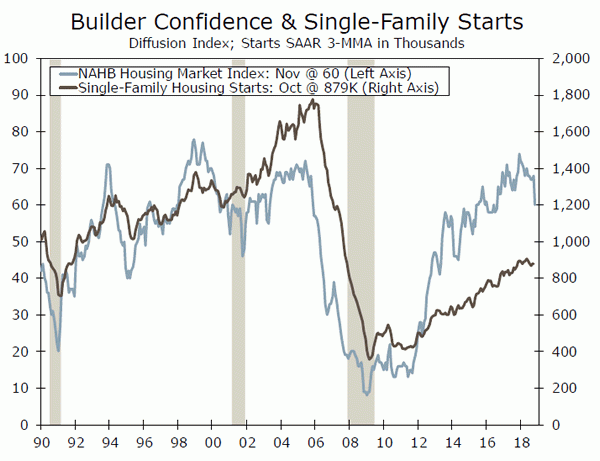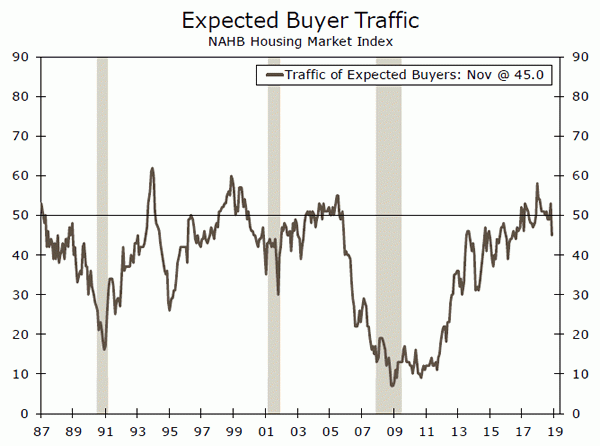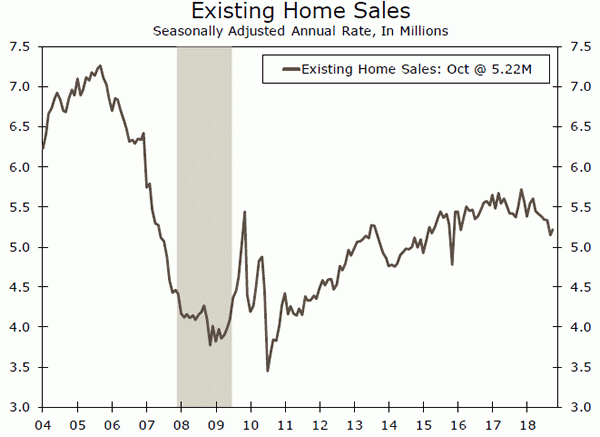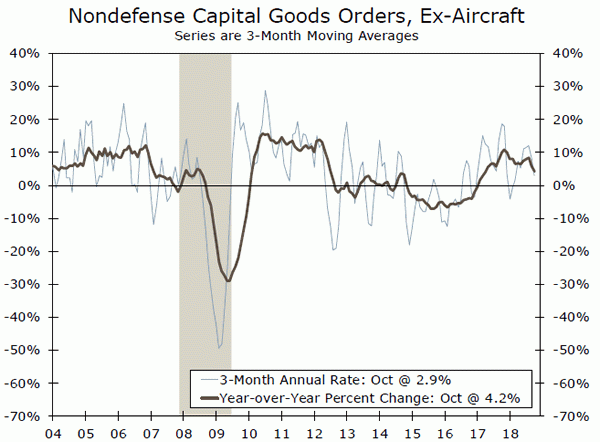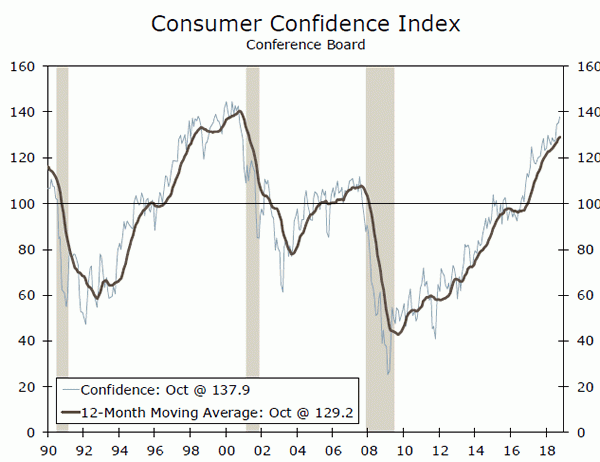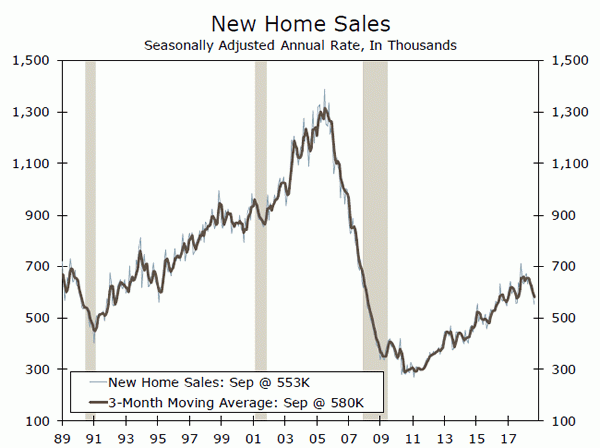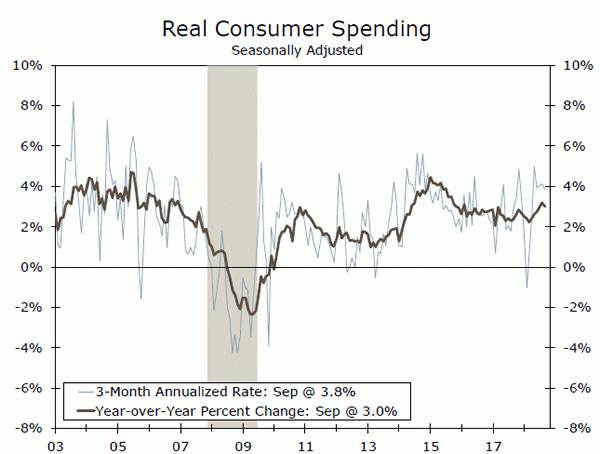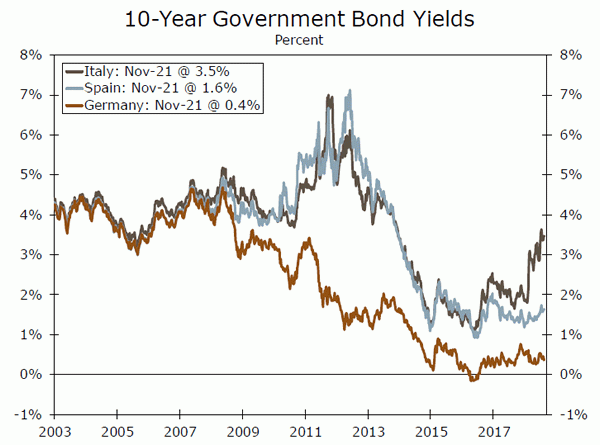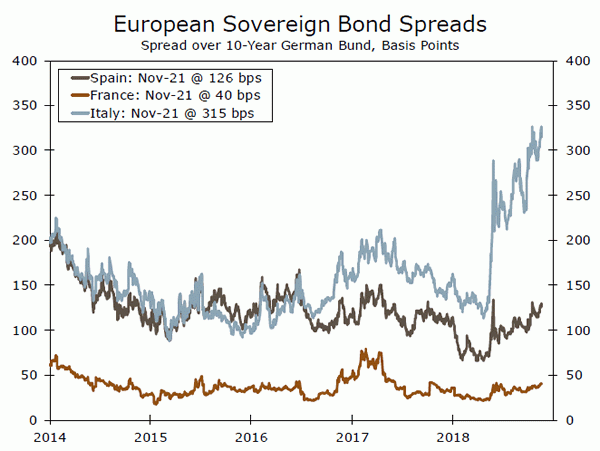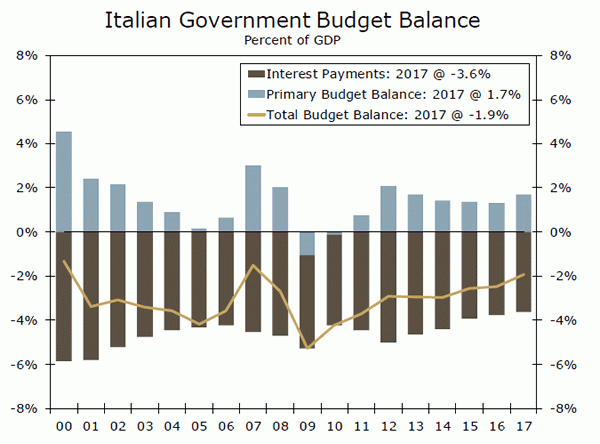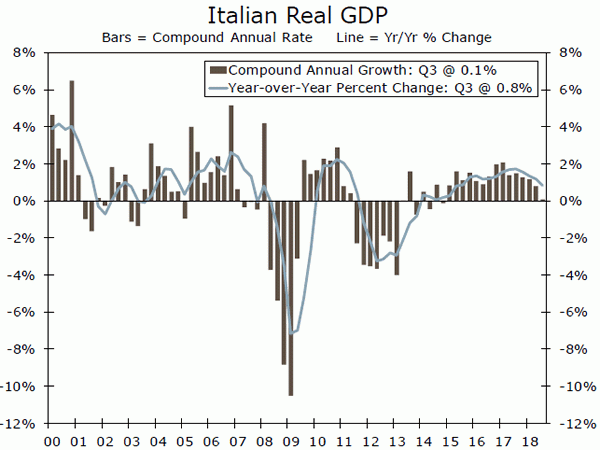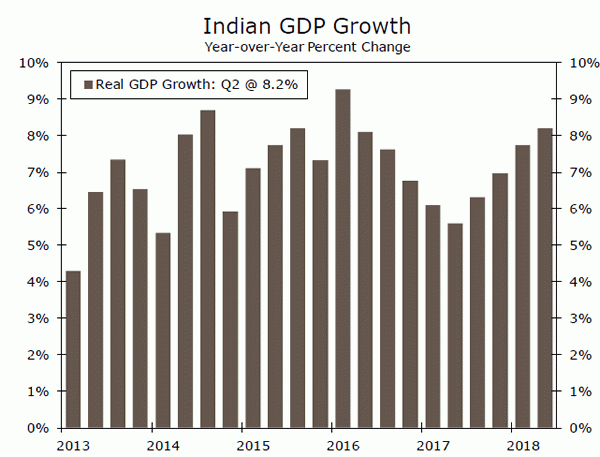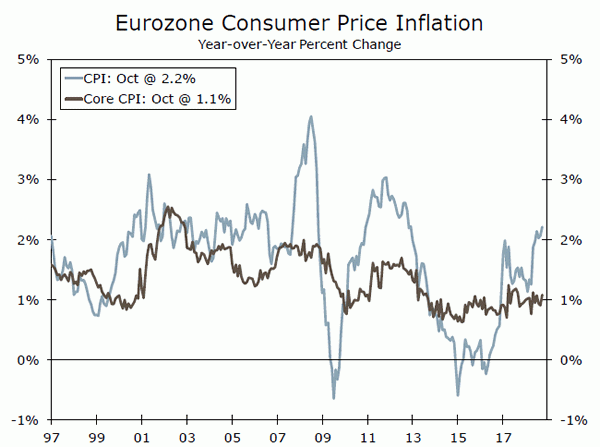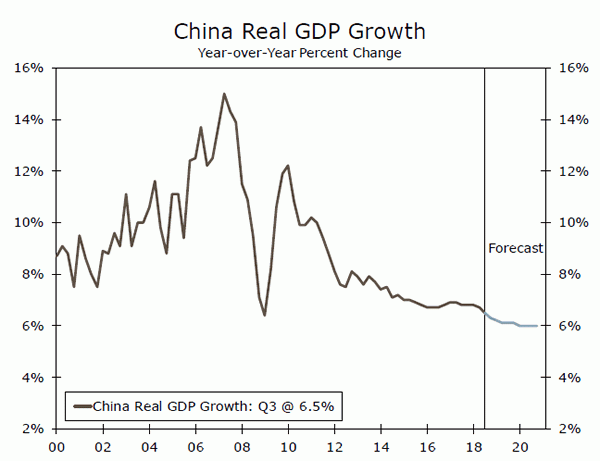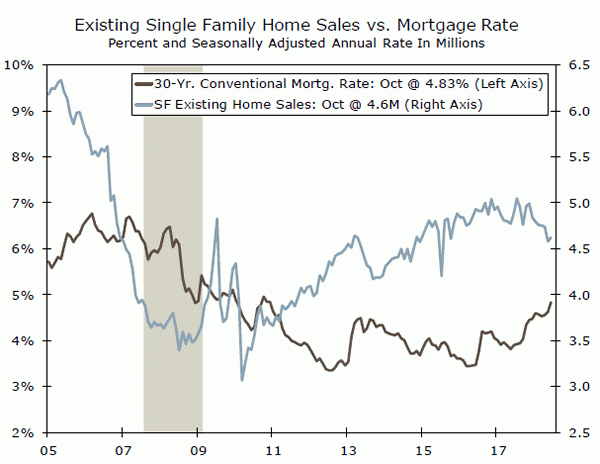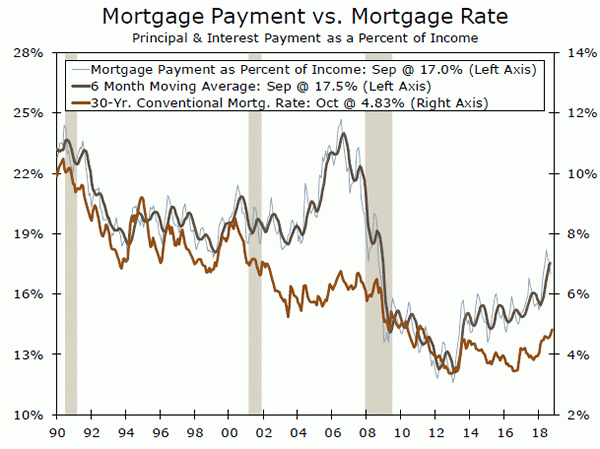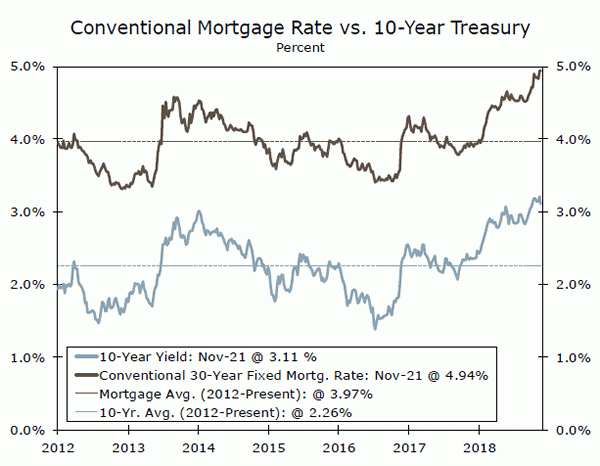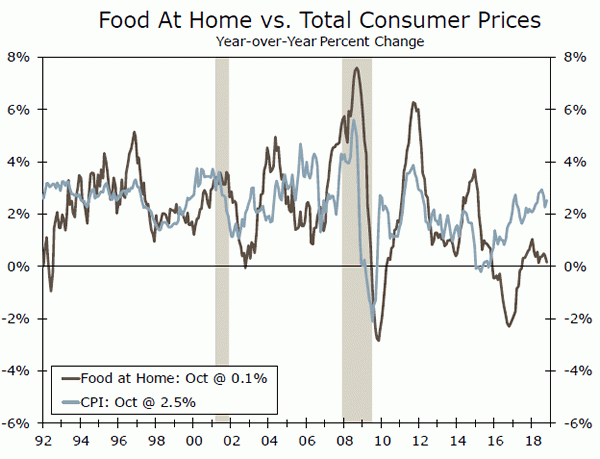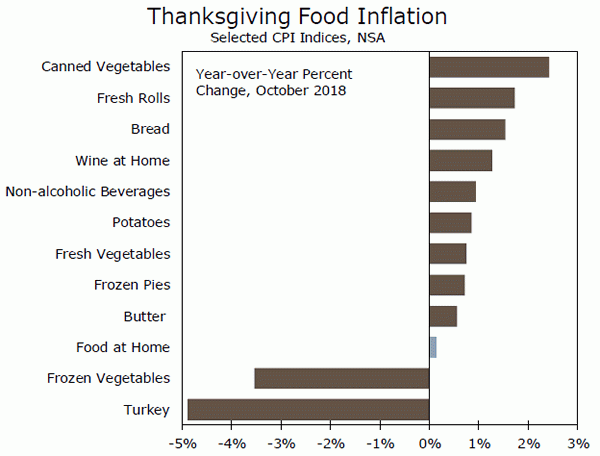U.S. Review
Housing Market Remains in Focus This Week
- Several housing-related indicators released this week point to a continued slowdown in the housing sector. The National Association of Homebuilders/Wells Fargo housing market index posted a sharp eight point decline in November, while housing starts and existing home sales eked out only moderate gains in October.
- Durable goods orders were also lackluster in October, with declines in the volatile defense and nondefense aircraft components contributing to the 4.4% headline drop. October’s data reinforce the likely continued moderation in business spending from the first half of 2018.
Housing Market Remains in Focus This Week
Several indicators released this week point to continued slowing momentum in the housing market. Arguably the biggest surprise in this week’s data was the eight point drop in the National Association of Homebuilders (NAHB)/Wells Fargo Housing Market Index in November (see chart on first page). This month’s plunge to 60 was the largest drop since February 2014, with declines in both builders’ assessment of current sales and future sales expectations indices. The expected buyer traffic index notably dropped below the 50 demarcation line, which means more builders see conditions as bad than good, and suggests the potential for further moderation in coming months (top chart).
At the same time, housing starts data also released this week point to weakness in the single-family market. While overall housing starts rose 1.5% in October, all of the gain was concentrated in the multifamily component, which rose 10.3%. Breaking down this gain further, projects with five or more units rose more than 6% over the month. This pickup primarily reflects apartment projects, and suggests that the multifamily market could have room for further upward momentum going forward. Conversely, single-family building permits declined 0.6% in October. Permits are running below starts, and point to single-family construction remaining lackluster in coming months.
We also learned this week that existing home sales rose 1.4% in October to a 5.220-million unit pace after declining 3.4% in September (middle chart). Although total sales rebounded in the month, the strength in October’s reading was concentrated in the condo/co-op component, which rose 5.3% in the month, compared to a lower 0.9% rise in single-family sales. Compared to a year ago, however, total existing sales are down more than 5%.
For homebuyers, while personal incomes continue to gradually pick up and most consumers maintain an optimistic economic outlook, rising mortgage rates will likely continue to weigh on affordability. To that end, revised consumer sentiment data for November released today confirmed that while consumers’ overall assessment of the economy largely remains positive, the home buying outlook is less bright. The percent of respondents stating home-buying conditions are good continued its downward trend to 64% in November’s final reading, while the survey also cited that “favorable home buying conditions remain at depressed levels.”
Finally, data on business spending were also less impressive this week, with durable goods orders declining 4.4% in October, on the heels of a downwardly revised 0.1% drop in September. The typically volatile defense and nondefense aircraft components fell sharply, and gains in other sub categories were also largely lackluster. Our preferred measure of core capital goods orders excluding aircraft was flat in October, and the three-month annualized rate dropped to its lowest since March (bottom chart). Although we look for business equipment spending to rebound in Q4 after only a 0.4% annualized gain in Q3, the October data reinforce that business investment will likely continue to moderate from the double-digit rates seen in the first half of 2018.
U.S. Outlook
Housing Starts • Tuesday
We learned earlier this week that the University of Michigan’s measure of consumer sentiment slipped only slightly in November despite choppy financial markets and worries about trade tariffs. On Tuesday of this coming week we get the Conference Board’s measure of consumer confidence, which has been running a little hotter than its University of Michigan counterpart in recent months. In fact, in October Consumer Confidence came in at an 18-year high. We would not drop our coffee if this report shows confidence coming off the boil here in November. The backdrop is still supportive of sustained confidence: the job market is solid, economy is still doing well and prices are not rising too fast. Still, the return of intense volatility in financial markets and concerns about rising interest rates may take some of the wind out of consumers’ sails. Previous: 137.9 Wells Fargo: 135.8
New Home Sales • Wednesday
The housing market has been a notable weak spot in an otherwise solid economy. The weakness here has become even more pronounced recently. For example, earlier this week, a widely followed sentiment measure for homebuilders posted its largest monthly decline in nearly five years in November.
To be fair, another release this week revealed that housing starts bounced in October, rising 1.5% after a 5.5% decline in the prior month. On Wednesday financial markets will digest two more reports on the state of the housing market when mortgage applications and new home sales both hit the wire.
Mortgage applications have fallen in five out of the past six weeks and new home sales have fallen in five out of the past six months. Rising rates and inventory issues are the primary headwinds and it is not immediately clear that either is moving in the right direction. Previous: 553K Wells Fargo: 575K
Personal Income & Spending • Thursday
On Wednesday of next week the Commerce Department will make its first revision to third quarter GDP figures. The first estimate showed real personal consumption expenditures came in hot in Q3, growing at an annualized pace of 4.0%.
The following day (Thursday), we’ll get an indication of how spending is holding up in the current quarter when the personal income and spending report for October hits the wire.
If the retail sales report for October is any indication, it looks like consumers kept on spending. Retailers reported the biggest increase in five months.
Meanwhile an extraordinarily tight labor market has yet to translate into meaningful and sustained growth in personal income. Previous: 0.2% & 0.4% Wells Fargo: 0.4% & 0.4%
Global Review
Italian Budget Drama Likely to Drag into 2019
- In a short week with limited foreign economic data releases, we focus this week on the ongoing Italian budget drama.
- Thus far, European Union officials have remained unsatisfied with the fiscal outlook in Italy, and an excessive deficit procedure against Italy appears increasingly likely.
- Were this to occur, financial penalties could be imposed against Italy some time in 2019. Both sides have multiple points along the way at which a compromise could be reached and financial penalties avoided.
- With neither side willing to back down so far, however, it seems likely the Italian budget drama will continue well into 2019.
Italian Budget Drama Likely to Drag into 2019
In a short week with limited foreign economic data releases, we focus this week on the ongoing Italian budget drama. Since our most recent special report on Italy, Italian policymakers have continued full steam ahead with their plans to ease fiscal policy next year through a combination of tax cuts and increased spending. As the process has dragged on, there have been multiple back and forth exchanges between Italian and EU policymakers. Italy has slowly made some modest concessions, such as lower deficit targets in 2020/2021 and a public asset sale back-up plan should next year’s target not be met. Through each iteration, however, Italy has stuck to its initial deficit target of 2.4% in 2019, up from approximately 1.8% in 2018 and well above the 0.8% target for 2019 proposed by the previous government back in April. Thus far, EU officials have remained unsatisfied.
Against this backdrop, Italy’s sovereign bond yields have remained elevated, and spreads over German yields are at multi-year highs. A sustained increase in interest rates presents an additional challenge for Italian public finances. Italy’s government is actually running a primary budget surplus at present (that is, revenues exceed noninterest expenditures), highlighting the extent to which interest costs on Italy’s sizable stock of debt weigh on public finances (middle chart). For now, interest rates have not risen so much that they surpass the levels of 5-10 years ago. As a result, much of the debt maturing today is still being refinanced at lower rates (See chart on front page. For reference, the weighted average maturity of Italian debt is about seven years.). However, another sizable leg up in bond yields that is sustained over time could start to pressure policymakers’ assumptions for the next few years, making the deficit target even harder to hit.
Complicating matters further, real GDP in Italy has been decelerating over the past year, and growth was barely positive in Q3 (bottom chart). Though we do not explicitly forecast Italian GDP, we do expect Eurozone growth more broadly to rebound modestly from its recent slowdown. Still, the momentum Italy had a year or so ago has clearly faded, making debt-reduction and growth targets all the more challenging to meet.
So what happens next? Today, the European Commission took another step towards an excessive deficit procedure (EDP) against Italy. In short, an EDP could be officially launched at some point in the next couple months, at which point Italy would have somewhere between three to six months after that to bring its fiscal trajectory in line with the European Commission’s demands. This timeline implies the process could come to a head sometime in mid-2019. Were Italy to continue to defy Brussels after this time has elapsed, the country could be subject to a penalty of 0.2% of its GDP, with growing penalties over time possible in the face of continued defiance by Rome.
Both parties, however, have multiple points along the way at which a compromise could be reached and financial penalties avoided. For now, neither side seems willing to blink, suggesting Italian bond yields will remain elevated for the time being and Italian budget headlines will continue to crop up over the course of 2019.
Global Outlook
India GDP • Friday
Amid concerns about a global growth slowdown, the Indian economy has been an outperformer of late. Real GDP in India has accelerated on a year-over-year basis in four consecutive quarters. Indian policymakers undertook a series of structural economic reforms over the past few years that, in part, led to a slowdown in growth. The drag on growth from these disruptions is clearly fading, however, and the long-term benefits combined with India’s favorable demographics suggest a positive outlook for the near-term and for potential growth.
That said, the Indian economy is not without its challenges. At present, consumer price inflation is just 3.3%, below the Reserve Bank of India’s target band of 4-6%. Budget deficit concerns continue to linger in the background, and a power struggle between the government and the central bank has been playing out in recent weeks. We expect Indian real GDP to continue to grow faster than both the global economy as a whole and its Chinese counterpart.
Previous: 8.2% (Year-over-Year)
Eurozone CPI • Friday
Though headline consumer price inflation in the Eurozone has surpassed 2%, core inflation has held very steady, hovering within +/- 0.1 percentage point of 1.0% since May. Though economic growth has slowed this year, it has remained above most estimates of potential growth, helping to drive additional tightening in the labor market. At 8.1%, the unemployment rate in the Eurozone has fallen half a percentage point thus far this year and is at the lowest level since 2008.
Monthly asset purchases by the European Central Bank declined from €60 billion a month to €30 billion a month to start 2018, and it looks likely that asset purchases will end entirely by the start of 2019. Our forecast assumes that going forward economic growth in the Eurozone levels off just shy of 2%, and that inflation strengthens enough that the ECB begins the next phase of normalizing monetary policy by hiking short-term interest rates in H2-2019.
Previous: 2.2%
G20 Summit • Friday/Saturday
The Group of Twenty (G20) Summit takes place next week over Friday and Saturday in Buenos Aires, Argentina. The G20 summit is always an important event, as the leaders of the 19 countries and the European Union represent 85% of global economic output and two-thirds of the world’s population.
This year, however, the summit has garnered additional attention as it appears that President Trump and Xi Jinping, the President of China, will meet to discuss the ongoing trade spat between the two countries. At present, the previous round of tariffs the United States place on $200 billion of imports from China are set to see an increase in the tariff rate from 10% to 25% on January 1. President Trump has further threatened tariffs on the remaining $267 billion in imports from China. Continued escalation between the two countries would represent an additional headwind to global growth headed into 2019, while progress towards a resolution would be a tailwind.
Point of View
Interest Rate Watch
Higher Mortgage Rates Hit Housing
Rising mortgage rates are likely playing a role in the recent housing market slowdown. Over the past six months, sales of both new and existing homes have weakened and home prices across the country have begun to moderate. This week also presented further evidence of a housing soft patch, as the NAHB/Wells Fargo Housing Market Index showed the sharpest drop in homebuilder confidence in nearly five years. Meanwhile, mortgage purchase applications have trended lower recently, falling 1.1% over the past year on a four-week moving average basis through the week of November 16.
Deteriorating affordability via the combination of higher home prices and rising mortgage rates is clearly having an impact. Over the past 12 months, the 30-year conventional mortgage rate has increased by nearly a full percentage point, rising from 3.89% to 4.94% through the first three weeks of November, the highest level since 2011. By historical standards, this still represents a relatively low rate. In fact, mortgage rates have been extremely low for much of the expansion. The 3.65% averaged in 2016 was not only the lowest of the cycle, but the lowest rate going back to 1971. Over that same period, the 30-year mortgage rate has averaged 8.10%, reaching as high as 16.65% in 1982. Still, the recent uptick represents a relatively significant increase. The average mortgage payment as a percent of income recently hit a cycle high of 17.6%.
Higher mortgage rates will likely continue to be a headwind for housing. The housing market is one of the most interest ratesensitive sectors of the economy and a primary transmission mechanism for monetary policy. As overall economic growth has continued to be solid, we anticipate that the Fed will continue to gradually hike the federal funds rate over the next year. Mortgage rates also tend to closely track 10-year Treasury yields. Since 2009, the spread between the conventional 30-year mortgage rate and the 10-year Treasury yield has averaged roughly 170 basis points. Given that we anticipate rates to rise across the entire Treasury curve in coming quarters, mortgage rates should continue to move higher through 2019.
Credit Market Insights
Stuffed with Debt?
Surging corporate credit spreads and equity market volatility over the past two weeks have raised concerns about financial conditions heading into the end of the year. We learned this week that aggregate household debt reached a record high for the 17th consecutive quarter, as total liabilities rose 1.6% to $13.5 trillion in Q3, according to the New York Fed’s Quarterly Report on Household Debt and Credit. Are U.S. households in a vulnerable positon after overindulging in debt? On the contrary, household debt as a percentage of disposable income remains near a twodecade low. Moreover, the portion of debt in some form of delinquency rose slightly over the quarter to 4.7%, but remains quite low by historical standards. Two main takeaways—household leverage has not returned anywhere near pre-recession levels, and households are relatively well positioned to service this debt.
With the Fed seemingly intent on marching ahead with rate hikes, it is not altogether surprising that corporate credit and equity markets are experiencing some late cycle anxiety. Financial market jitters aside, household financial balances are not flashing any particularly ominous warning signs—yet. The majority of household debt is in fixed rate mortgages, many of which were refinanced to lower rates postrecession, and wage growth has finally breached 3% amidst a very strong labor market. As households gather around the table this week, the fundamentals remain supportive of optimism—for now.
Topic of the Week
Some Food for Thought on Inflation
As inflation has turned up this year, one area households are catching a break is prices at the grocery store. The Consumer Price Index is up 2.5% over the past year, but prices for food at home are up just 0.1%. That continues a multi-year trend in which food has trailed broader inflation (top chart). Intense competition at the grocery store and low prices for many agricultural commodities amid what seems to be ever-larger harvests have been holding down food prices. Retaliatory tariffs on agricultural and livestock products have only added pressure. Prices of soybeans, a common ingredient for livestock feed, are at the lowest levels in more than a decade, while pork prices are at a five-year low.
With food prices under the gun, Thanksgiving should be a bit less expensive this year. The American Farm Bureau Federation’s informal survey estimates the price of dinner this year is down 0.4% this year, which is the third consecutive decline. Many common Thanksgiving items are actually up over the past year, with a notable exception: turkey (bottom chart). Lower feed prices have pushed Turkey prices down 4.9% over the past year.
The CRB food index, which leads food at home by about six months, is down about 4% over the past year and suggests grocery store prices will continue to weigh on headline inflation in the coming months. More generally, lower commodity prices, driven in part by the dollar remaining strong and global growth slowing, have dialed back expectations for inflation next year.
The deteriorating global inflation dynamics represent a downside risk to inflation next year, along with the slowdown in housing hitting the sizeable shelter component of inflation. But there are upside risks to inflation next year as well. Tariffs and capacity constraints could push inflation higher than our current expectation for core PCE inflation to average 2.2% in 2019. For a deeper discussion on inflation risks in the year ahead and the Fed’s expected reaction, see Will Goldilocks Inflation Stay in 2019?.




